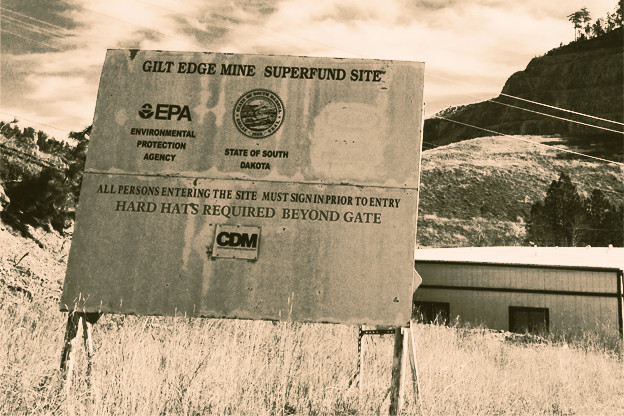

How do you drown-proof a mine?
It’s the question on everyone’s lips
DNR commissioner Landwehr says legacy issues of mines require a bankruptcy-proof reclamation plan for Polymet pic.twitter.com/sLX3Kbp3ug
— John Croman (@JohnCroman) October 27, 2015
As a preliminary matter, you have wonder who got rubbed off the sign in the photograph above.
The photo and tweet above are from a presser at the end of a field trip the Governor and the Commissioner took to the Gilt Edge Mine disaster in South Dakota on October 26th.
A “bankruptcy-proof reclamation plan” is a great idea, but it’s harder than it looks. Let’s just hope the Commissioner sticks to the sentiment.
Bankruptcy has always been a pesky problem for creditors or claimants of all kinds. The earliest way to deal with the problem was to require debtors to sign an agreement not to go bankrupt. That isn’t enforceable, of course.
No loan agreement is complete, though, without a sheaf of paper dedicated to limiting or eliminating the ability of a debtor to go bankrupt or seek the protection of bankruptcy laws. It’s almost all completely useless.
There. I said it.
What else can be done?
One easy step would be to the the guaranty of the “senior” mining companies that the “junior” mining companies front for. In the case of the junior PolyMet Mining, that would be Glencore, PLC. Glencore is not a majority shareholer of PolyMet, but between the capital it has invested, and the money it has loaned to PolyMet, Glencore’s footprints are all over PolyMet’s balance sheet.
At a hearing before a Minnesota House committee in early 2014, the chief of the Land and Minerals Division of the Department of Natural Resources, Jess Richards, dismissed the idea of a Glencore guaranty. Perhaps, based on the Commissioner’s remarks, the DNR’s thinking has evolved since then. Say, was Jess Richards on the field trip?
Not that a guaranty would be a panacea, given the near tanking of Glencore itself in the stock market recently. But it’s a start.
In the private financial sector, another thing that’s often done is to get a security interest in the assets of the debtor. A security interest survives a bankruptcy, and it gives the creditor a resort to the assets of the debtor to satisfy the creditor’s claims. Give the State of Minnesota a first lien in all the assets of the mine, real estate, equipment, inventory, and all intangibles, including cash, now owned, or hereafter acquired, as we say in the biz, to satisfy environmental claims.
Glencore has a first lien in all of PolyMet’s assets right now, so it must think having one is pretty slick. If there was a mine disaster with the current capital structure, by the way, Glencore would get its loans back before the state got any reclamation money or anybody downstream got any money for their dead wild rice.
But you say, that would never work! No bank would ever loan money to PolyMet if the state had a first lien in everything. That’s true, but it should tell you something, too.
It should tell you that unless the state and all the people with the dead wild rice are the tail-end Charlies, the mine won’t work. This is a brutal, but simple truth.
So, who wants to be the stuckees? PolyMet and Glencore want it to be you, my resident and taxpaying Minnesota friends.
We could also treat PolyMet the way we treat insurance companies and banks, requiring it to establish liquid capital reserves sufficient to satisfy potential claims before operations commence, while they continue, and for so long thereafter as the threat of acid mine drainage continues after the mine closes.
The dinky little Gilt Edge mine that the Governor and the Commissioner visited this week is about to get $50 million to help clean it up. Think what might be required to treat water indefinitely and deal with a disaster like Mount Polley from the Great Sulphur Hole and tailing cesspool that PolyMet wants to create.
If the reserves fell below the required amount, mining stops and a liquidating receiver comes in to auction it off.
But just as the case of a lien for the state, if this is unworkable, it demonstrates that the mine is uneconomic when its true costs are accounted for.
I have some more ideas about this, but they’ll have to wait until next time.
Update – reader Alan suggests:
The state would be way better off to heavily subsidize some other non-polluting industry to locate on the range. At least if it failed or went bankrupt, we wouldn’t be paying for cleanup for the next several dozen generations or be stuck with cleanup that couldn’t be mitigated. Another option would be to do things like they do in the South and get our congress critters to pull strings to locate a giant job-creating military base up there.
Steve adds: I hear there may be a new blimp repair station needed soon. Get on this right away, Rick Nolan! Alan’s right; it’s much better than mining.
Thanks for your feedback. If we like what you have to say, it may appear in a future post of reader reactions.

